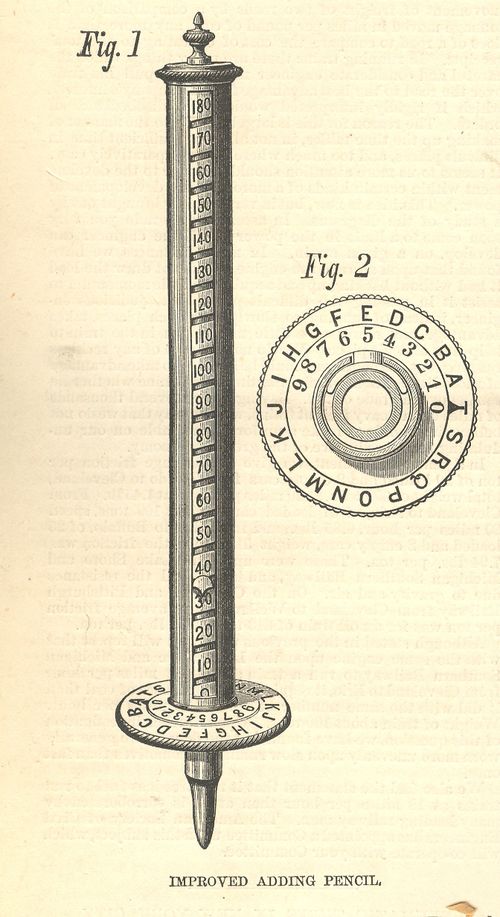United
States
Patent Office.
MARSHALL M. SMITH, OF
GEEE1Í TOP, MISSOUEI.
IMPROVEMENT IN
ADDING-PENCILS.
Specification forming
part of Letters-Patent No. 180,949, dated August 8, 1876 ; application
filed
July 11, 1876.
To all whom it may
concern:
Be it known that I,
Marshall M. Smith, of
reen Top, county
of
Schuyler
,
and State
of Missouri
, have invented a new and Im-
proved Adding-Pencil,
of which the following-
is a specification :
Figure 1 is a side view
of my improved
„ pencil, part being
broken away to
show the construction.
Fig. 2 is a cross-sec-
tion of the same taken
through the line x x,
Fig. 1.
The object of this
invention is to furnish
an improved adding-pencil,
simple in con-
struction, inexpensive
in manufacture, con-
venient in use, and
reliable in operation.
The iuventiou consists
in the combination
of the flange provided
with the nine digits
and zero, and the
milled flange provided with
the letters, with the
slotted case, and the
grooved cylinder, as
hereinafter fully de-
scribed.
Similar letters of
reference indicate corre-
sponding parts.
A is a hollow cylinder,
which is slotted lon-
gitudinally, and in
which is placed a cylinder,
B. The cylinder B is
swiveled at its upper
end to the upper end of
the case A, and has
a spiral groove formed
in it, from its lower to
its upper end, to
receive the pointer, which
is forced up the slot
of the case A and the
groove of the cylinder
B, by turning the said
cylinder within the
said case. Upon the cyl-
inder B, along the
spiral groove, or between the
coils of said groove,
is formed a series of con-
secutive numbers.
Around the lower end of
the case A is formed a
ring-flange, D, upon
which is formed the
nine digits and the zero,
as shown in Fig. 2. Around
the lower end
of the cylinder B is
formed a ring-flange, 0,
upon which are formed
the. letters of the al-
phabet, or as many of
said letters as there are
numbers in each coil of
the cylinder B. The
edge of the flange C is
milled, to enable it to
be more easily turned.
Upon the lower end
of the cylinder B is
formed a pencil or point-
er, E.
In using the pencil to
add up a column of
figures, as the point E
is placed upon a figure
to be added, the eye
seeks the same figure
upon the flange D, and
notices the letter upou
the flange C, that
stands directly opposite
said figure. The flange
C is then turned to
bring the said letter
opposite the zero upon
the said flange D. This
turns the cylinder B,
and carries the pointer
up the groove a corre-
sponding distance, and
it now points to a
number upou said
cylinder equal to the sum
of the said figure and
the number previously
obtained.
When the column has
been added, and the
sum noted, the cylinder
is turned back to
bring its pointer to
the zero-mark of its num-
bers, and the next
column is added in the
same way, and so on.
Having thus described
my invention, I claim
as uew and desire to
secure by Letters Pat-
ent—
The combination of the
flange D, provided
with the nine digits
and zero, and the milled
flange 0, provided with
the letters, with each
other, and with the
case A and the grooved
cylinder B,
substantially as herein shown and
described.
 I've seen a number of unusual calculating machines, but this one--patented by Marshall Smith in 1876) seems one of the smallest, and efficient--if not limited--varities. It is the second edition so-to-speak of a mechanical, graphite pencil, operating this time without rotors or any other internal mechanical devices. It was evidently a big seller--hosted in part, so it seems, by The Scientific American itself--having sold some 5,000 units.
I've seen a number of unusual calculating machines, but this one--patented by Marshall Smith in 1876) seems one of the smallest, and efficient--if not limited--varities. It is the second edition so-to-speak of a mechanical, graphite pencil, operating this time without rotors or any other internal mechanical devices. It was evidently a big seller--hosted in part, so it seems, by The Scientific American itself--having sold some 5,000 units. 


The Rechnerlexicon has full PDFs of this patent, as well as the one for its earlier incarnation coinvented with Fletcher W. Potts:
http://www.rechnerlexikon.de/files/patent/US180949.pdf
http://www.rechnerlexikon.de/files/patent/US175775.pdf
The Adding Pencil Co. of St Louis, MO, was still selling them through ads in Popular Science and Popular Mechanics in the mid-1920s. For instance: http://tinyurl.com/kv4eks
Posted by: Ray Girvan | 02 August 2009 at 09:01 AM
Am I mis-reading or is the Adding Pencil Co. ad misleading? It seems to be claiming that all you do is press the pencil tip on some numbers and it adds them automatically. Must one behave like a counting horse and press the tip nine times for "nine"? Then it continues and says that it adds as you write. This is all different, I think, from the claims in the patents above. Would've been a late-night TV ad, if they'd had TVs.
Posted by: Jeff | 02 August 2009 at 04:34 PM
The one in the ad looks as if it operates in a different way from the dial-twist of the 1876 one. The graduations near the tip suggest that to add x, you push down until the tip slides into the body of the pen by x notches, and x is added to the total (after which presumably the tip disengages and springs back ready for the next input).
If you zoom in on this other ad in Popular Science - http://tinyurl.com/ls2vgb - you can see the graduations are numbered consistently with this.
Posted by: Ray Girvan | 02 August 2009 at 05:11 PM